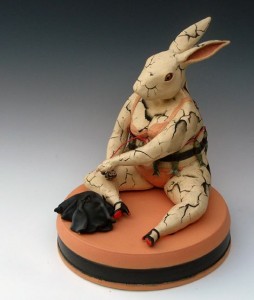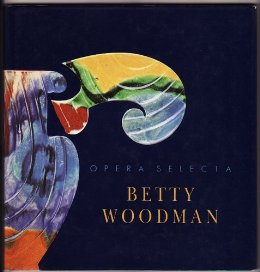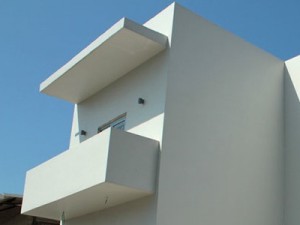Amber Aguirre will be our artist-in-residence for the month of August.
Amber is the recipient of NCECA’s International Residency grant for 2013. Partnering with NCECA for this unique residency program offers the Benyamini Center wide international exposure and an opportunity to engage in international professional, cultural and creative exchange. We are honored and thankful to NCECA for collaborating with us.
Amber, a graduate of San Francisco State University, currently lives, teaches and creates in Hawaii.
Most of her work is figurative sculpture which enhances a narrative used to comment, observe and explore the human condition.
As the child of a Holocaust survivor I was indoctrinated from a young age into awareness of the fear, apathy, and victimization inherent in human cultures. Throughout history artists have functioned as social commentators. I use human and anthropomorphic figures as the vehicle to explore the results of these prevalent emotions on society.
To accentuate the narrative the artist developed a unique technique – “Naked Fauxku” which reproduces a likeness to Naked Raku but is created in a high fire, oxygenated atmosphere with no reduction. It creates a cracked and painful looking surface that adds subliminal meaning to the work by visually suggesting breakage and disintegration.
www.amberaguirre.com
Betty Woodman:
“I make things that could be functional, but I really want them to be considered works of art”.
Betty Woodman Is a renowned, established ceramic artist – known for her vibrant deconstructed vases that are influenced by art history and ceramic culture. Her works are found in fine art collections of leading museums as well as venues showing craft.
“It was not, ‘One day I’m a potter, and the next day I’m an artist.’ It was a gradual expansion”.
Woodman was born in the USA in 1930, studied ceramics at Alfred University, and began her career making wheel thrown functional vessels that she and her artist husband decorated. With time she broke away from the traditional ceramic pot and looked for new directions in deconstruction, influenced by the New York artists of the Pattern and Decoration Movement although remnants of the basic vessel form are still evident in her work.
“It’s there throughout the history of art, there’s always a vessel. No matter where you look, there’s a pitcher pouring water, there’s a vase sitting there”.
Her sculptural work is a play between 2D and 3D with the ceramic surface becoming her `canvas`, creating large compositions as wall pieces employing light and shade as well as positive and negative as integral parts of her work. She is still an active artist working in New York and Italy and showing in galleries and museums around the world.
Bibliography:
- Clark, Garth, Strauss Cindi (2012). Shifting Paradigms in Contemporary Ceramics: The Garth Clark and Mark Del Vecchio Collection, U.S.A: Yale University Press in association with the Museum of Fine Arts, Houston
- Henriques, Paulo, (edited by), (2006). Teatros, Theatres, Theaters, Milan: Skira
- Woodman, Betty (1990). Opera Selecta, Hague: Gegevens Koninklijke Bibliotheek
Celebrate with us the Benyamini Center’s 1 year birthday!
A street party with our new neighbor – ALARAMPA restaurant
DJ Ofer Schoolmaster (The Apples)
Thursday evening 21/6/12
Students of Bezalel Academy of Arts and Design, Jerusalem, visiting the Benyamini Center, December 2011
[nggallery id=78]
Miri Krimilovski interviews Marcelle Klein about Beit Benyamini on the morning program of Reshet Bet on 20.7.11 Miri Krimilovski – Benyamini house is the new Contemporary Ceramics Center
MP3 file playing in a new window
Marcel Klein, Shlomit Bauman, Ronit Tzur, Ravi Latzer, poetry Silverstone and Esther Beck
[nggallery id=47]
The building on Ha-Amal street number 17 in Tel Aviv was purchased. The building, once renovation is completed, will house – in its 3 stories, a roof top and a small garden with an old pomegranate tree – the Benyamini Center and its activities. images of the building before renovation began are on a gallery on this page. A Google map, also here, provides directions.
Ha-Amal (the street’s name) is the Hebrew word for “labor”. Issachar, who appreciated workmanship and labor, would have loved it…
[nggallery id=1]




